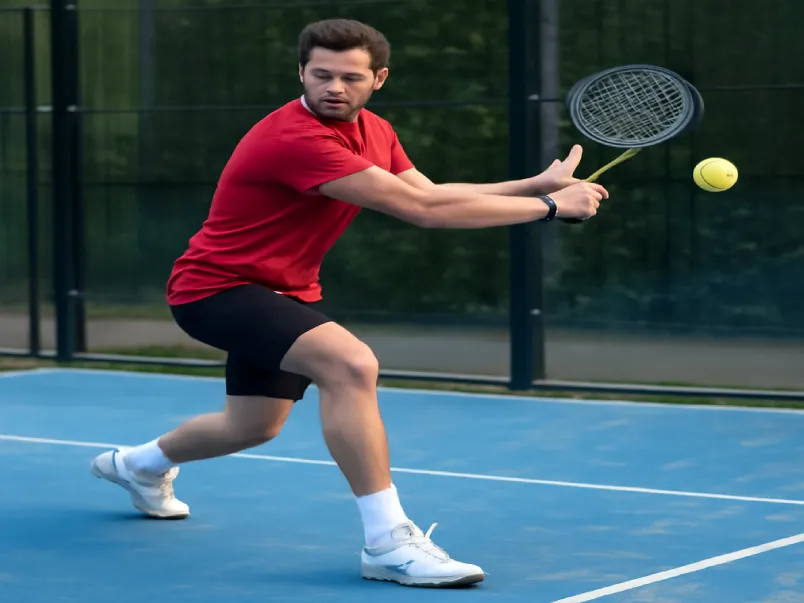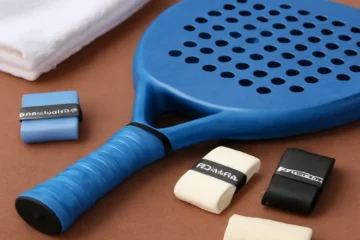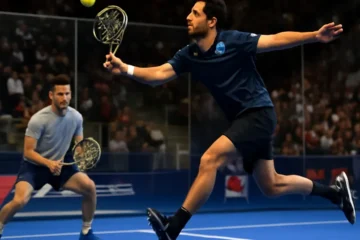Imagine this scenario: You’re in the heat of a padel match, your opponent delivers a fast, powerful shot, and you instinctively go for your backhand. But instead of executing a smooth, controlled shot, your backhand falls short, missing the target. You feel frustrated, knowing that a weak backhand is costing you valuable points. This situation happens more often than we’d like to admit, but the good news is that mastering your backhand in padel is within your reach.
A solid, reliable backhand is one of the most important shots in your padel arsenal. Whether you’re rallying at the baseline or attacking at the net, your backhand can make or break the game. It’s not just about hitting hard; it’s about control, technique, and knowing when to use the right shot for the right situation. In this article, we will walk you through the process of mastering your backhand, from grip and stance to advanced techniques and common mistakes.
The Importance of the Backhand
In padel, the backhand is an essential shot that is used frequently during both defensive and offensive play. Whether you’re hitting from the baseline, executing a volley at the net, or defending against a powerful shot, a reliable backhand can make all the difference. It serves as a foundation for many other aspects of your game, offering stability and control during rallies.
Unlike tennis, where players often favor one dominant side (forehand or backhand), padel requires a player to be versatile with both hands. The backhand allows for greater consistency, helps manage different ball heights, and is crucial for reacting to opponents’ shots. Mastering the backhand transforms you into a more complete and confident player, improving both your defense and offense.
Thesis Statement
Anyone can develop a powerful and consistent padel backhand by focusing on the fundamentals—grip, technique, and targeted practice. With the right approach, patience, and consistent practice, you can unlock the full potential of your backhand.
Part 1: The Foundation – Grip, Stance, and Ready Position
1. The Continental Grip: Your Best Friend
The foundation of a good backhand begins with your grip. One of the most critical elements of padel is the Continental Grip, commonly referred to as the “hammer grip.” This grip is used for almost every shot in padel, including the backhand, and is essential for versatility.
Why the Continental Grip? It allows for a natural slice, easier volleys, and better control at the net without the need to switch grips. This means you can seamlessly transition between different shots without having to adjust your hold, creating fluidity and consistency in your game.
How to find it:
- Start by holding the racket as if you were shaking hands with it. The base knuckle of your index finger should rest on bevel #2 of the racket handle.
- Your other fingers wrap comfortably around the handle, with your thumb placed along the back of the handle for added control.
Benefit: The Continental Grip creates an optimal balance between control and power. It allows you to hit a variety of shots, from powerful backhands to delicate volleys and slices, making it the ideal grip for all-around play.
2. The Ready Position and Footwork
Before you even hit the ball, your stance and footwork play a critical role in setting up your backhand. A proper ready position sets the foundation for a fluid and controlled shot.
Stance:
- Begin with your knees slightly bent, your weight on the balls of your feet, and your racket in front of you, ready to react. This position ensures you are balanced and prepared to move quickly in any direction.
The Unit Turn:
- When the ball is approaching, make sure to execute a unit turn, which involves rotating your shoulders and hips as a unit to prepare for the shot. Don’t just swing with your arm; using your entire body will provide more power and control.
Footwork:
- Small adjustment steps are key. Move quickly to get into position, ensuring your body is aligned to strike the ball cleanly. A good backhand requires not just arm movement but whole-body coordination. Practice quick, efficient footwork to maintain balance and positioning.
Part 2: Executing the Core Backhand Shots
3. The Basic Two-Handed Backhand (from the back of the court)
The two-handed backhand is a go-to shot for most padel players, especially for handling deep and comfortable balls. It offers more control, stability, and power compared to the one-handed backhand.
When to use it: This shot is best used when you have time and space to make a full swing. It’s ideal for receiving deep balls or when you want to establish dominance at the baseline.
The Technique, Step-by-Step:
- Preparation: Start by turning your shoulders early, with the racket pulled back with both hands, keeping the racket face parallel to the ground.
- Swing Path: Focus on a smooth, low-to-high motion, where your elbow leads the swing. The body rotation helps generate power while maintaining control.
- Contact Point: Aim to make contact slightly in front of your body, around waist height. This helps maintain consistency and control.
- Follow-Through: Extend the racket towards your target and finish the swing over your shoulder, ensuring that you are ready to recover quickly for the next shot.
4. The Defensive Slice Backhand
The slice backhand is a vital tool for defense, especially when you’re out of position or facing a low ball. It helps you regain control and gives you time to recover.
When to use it: Use this shot when you’re under pressure, facing a low ball, or need to neutralize an opponent’s attack. It’s also effective for returning balls with heavy spin or pace.
The Technique, Step-by-Step:
- Preparation: Take a high backswing, with the racket face slightly open to prepare for the slice.
- Swing Path: Move the racket in a high-to-low motion, cutting through the ball. This “carving” motion is what generates the backspin.
- Contact Point: Brush the back of the ball gently to create backspin.
- Result: The ball will float, slow down, and give you a chance to recover and reposition yourself.
5. The Backhand Volley
The backhand volley is an essential shot for dominating the net. A good volley can be the difference between winning a point and being forced to play a defensive rally.
The Key to Net Dominance: The volley is often your most frequent backhand shot when you’re close to the net, as you’ll need to react quickly to your opponent’s shots.
Technique:
- Use a short, compact, punchy motion. Don’t try to swing too much; instead, focus on redirecting the ball with precision.
- Your legs play a crucial role, so bend your knees and push off your legs for power.
- Keep your wrist firm to maintain control over the ball and avoid “flicking” it.
Placement: Aim to place your volleys either to the corners or at your opponent’s feet to make it harder for them to return.
Part 3: Advanced Techniques and Strategy
6. Generating Power and Control
Power isn’t just about arm strength. Generating power in your backhand comes from your legs, core, and body rotation.
Core and Legs: Focus on transferring weight from your back leg to your front leg while rotating your hips and shoulders. This helps generate power without sacrificing control.
The Wrist: Keep your wrist firm. Avoid flicking your wrist, as this can result in inconsistent shots and a lack of control.
7. The Bandéja and Víbora: The Attacking Backhand Shots
For more advanced players, the Bandéja and Víbora are attacking shots that can be used to gain control of the net and win points.
Bandéja (The Tray Shot): The Bandéja is a defensive yet effective shot used to maintain your position at the net. It involves a high, controlled volley that forces your opponent back.
Víbora (The Viper Shot): This is a more aggressive, spin-heavy shot designed to hit winners. It’s an attacking variation of the Bandéja that creates more spin and opens up angles.
When to Use: The Bandéja is typically used in a defensive situation to keep your opponents at bay, while the Víbora is used when you’re looking to take control and win the point.
8. Using the Walls: The Backhand Rebo
In padel, using the walls is a unique feature that can turn the tide of the game. The Backhand Rebo involves using the side or back walls to play the ball, often resulting in tricky bounces that can confuse your opponent.
Technique:
- Stay patient and watch the ball as it bounces off the wall.
- Use a controlled slice or flat shot, ensuring that you aim for a position that limits your opponent’s options.
Part 4: Common Backhand Mistakes and How to Fix Them
Mistake 1: Using a Tennis-Style Western Grip
Fix: Commit to the Continental grip for all shots. It’s versatile and allows you to hit both backhands and volleys with ease.
Mistake 2: Swinging with Only the Arm
Fix: Engage your core and shoulders, ensuring a unit turn as you swing. This will generate more power and improve your consistency.
Mistake 3: Hitting the Ball Too Late
Fix: Focus on your footwork to get into position early, allowing you to contact the ball in front of your body.
Mistake 4: Trying to Be Too Powerful on Every Shot
Fix: Prioritize consistency and placement over raw power. The best players know how to control the ball and place it where it’s difficult for the opponent to reach.
Part 5: Drills to Solidify Your Backhand
Drill 1: The Wall is Your Best Friend
A simple solo drill where you practice hitting against a wall. Focus on form and consistency. The wall will help you develop muscle memory for a reliable backhand.
Drill 2: Cross-Court Rallies
Practice with a partner, focusing on consistent backhand-to-backhand exchanges. This helps you improve accuracy and timing.
Drill 3: Volley-to-Volley at the Net
Practice quick, compact backhand volleys with a partner at the net. This drill will help you develop better reactions and control when playing close to the net.
Conclusion
Mastering your padel backhand is a journey, but with the right fundamentals, practice, and focus, you can turn it into one of your most reliable shots. By understanding the importance of the Continental grip, perfecting your core backhand shots, and addressing common mistakes, you’ll build a backhand that is both powerful and consistent. Keep practicing, stay patient, and celebrate the small victories along the way. A reliable backhand transforms you from a defensive to an offensive player, giving you the confidence to control the court. Now, go out there and put in the work to master your backhand!
FAQs
1. What is the best grip for a padel backhand?
The best grip for a padel backhand is the Continental grip. This grip provides versatility for both forehands and backhands, allowing for better control and a variety of shots such as volleys, slices, and powerful backhands.
2. How can I improve my padel backhand?
To improve your padel backhand, focus on mastering the fundamentals: the proper grip, stance, and footwork. Regularly practice the basic two-handed backhand, defensive slice, and backhand volleys. Additionally, incorporate advanced techniques like the Bandéja and Víbora for a more attacking backhand.
3. What is the difference between the Bandéja and Víbora in padel?
The Bandéja is a defensive, high volley used to keep your position at the net, while the Víbora is a more aggressive, spin-heavy backhand used to win points. Both are advanced shots, but the Víbora is more offensive and difficult to return.
4. When should I use a slice backhand in padel?
A slice backhand is ideal for situations where you’re out of position or need to return a low ball. It’s also effective when defending against fast, hard-driven shots, allowing you to regain control and buy yourself time to recover.
5. How do I avoid common mistakes with my padel backhand?
Common mistakes include using a tennis-style grip, relying too much on your arm, hitting the ball late, or trying to hit with too much power. To fix these mistakes, commit to the Continental grip, engage your core, focus on footwork, and prioritize consistency over raw power.
6. What are some good drills to practice my padel backhand?
Effective drills for improving your padel backhand include:
- Wall drills: Practice hitting against a wall to develop muscle memory.
- Cross-court rallies: Work with a partner to focus on consistent backhand exchanges.
- Volley-to-volley drills: Practice compact, reactive backhand volleys with a partner at the net.




